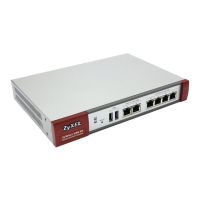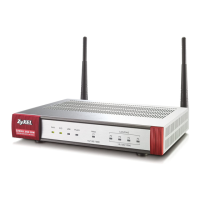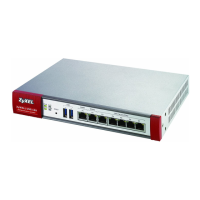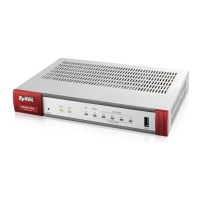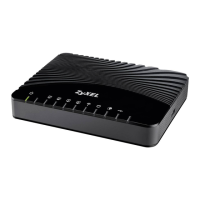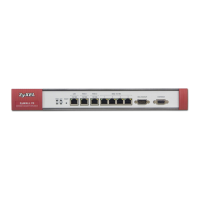Do you have a question about the ZyXEL Communications ZyWALL USG100-Plus and is the answer not in the manual?
Introduces ZyWALL application scenarios and configuration tutorials.
Describes security features like firewall, intrusion detection, anti-virus, and anti-spam.
Explains ZyWALL's IPv6 capabilities, including routing and tunneling methods.
Covers setting up VPN tunnels for secure remote access to the network.
Details SSL VPN for remote users accessing the network via web browsers.
Allows policies to restrict access based on user, sensitive information, and shared resources.
Explains balancing traffic loads across multiple internet connections.
Describes default configurations for zones, interfaces, and physical ports.
Outlines the different methods available for managing the ZyWALL.
Details using the Web Configurator for easy ZyWALL setup and management.
Describes using text-based commands for configuring the ZyWALL via remote access.
Introduces Vantage CNM for managing multiple devices.
Requirements for using the Web Configurator, including browser versions and settings.
Step-by-step guide to accessing the ZyWALL's Web Configurator using default credentials.
Instructions on how to play a video explaining the Web Configurator.
Explains the division of the Web Configurator screen into title bar, navigation panel, and main window.
Describes the icons in the title bar and their functions.
Details how to use the navigation panel menus to open status and configuration screens.
Describes the dashboard for displaying general device information and status widgets.
Explains how monitor menu screens display status and statistics information.
Explains using configuration menu screens to set up ZyWALL features.
Covers managing configuration, firmware, diagnostics, and rebooting the ZyWALL.
Explains how tables and lists in the Web Configurator are flexible for displaying entries.
Instructions on safely shutting down the ZyWALL to prevent firmware corruption.
Steps for mounting the ZyWALL on an EIA standard size rack or in a wiring closet.
Introduces the ZyWALL's front panel.
Describes the status and meaning of the front panel LEDs.
Using wizards for quick configuration of Internet and VPN settings, and subscription services.
Tutorial on configuring Ethernet interfaces, port roles, and zones for network setup.
Steps to assign a static IP address to the WAN1 interface.
How to assign the P5 port from the lan2 interface to the dmz interface.
Steps to move a VPN tunnel from one zone to a new zone.
Guide to configuring cellular interfaces for WAN connections using a 3G USB card.
Details configuration screens for Ethernet, PPP, VLAN, Bridge, and Policy Routing.
Example of configuring WAN and LAN interfaces for pure IPv6 routing.
Steps to enable interface and IPv6 on the WAN1 interface using SLAAC.
Steps to configure the LAN1 interface for IPv6 with router advertisement.
Instructions for playing a video example of pure IPv6 routing.
Explains configuring prefix delegation and router advertisement on WAN and LAN.
How to apply a network prefix from an ISP for IPv6 configuration.
Steps to set up the WAN IPv6 interface using DHCPv6 prefix delegation.
Steps to set up the LAN interface for IPv6 with prefix delegation and router advertisement.
Instructions to test the IPv6 configuration by connecting a computer to LAN1.
Instructions for playing a video on prefix delegation and router advertisement.
Troubleshooting common issues with IPv6 auto-configuration and prefix delegation.
Guide to creating an IPv6 6to4 tunnel for IPv6/IPv4 connectivity.
Explains the packet flow for 6to4 tunnel settings.
Steps to set up the LAN IPv6 interface for a 6to4 tunnel.
Steps to create a 6to4 tunnel interface with a relay router.
Instructions to test the 6to4 tunnel configuration.
Instructions for playing a video on setting up an IPv6 6to4 tunnel.
Troubleshooting common issues with IPv6 6to4 tunnels.
Guide to creating an IPv6-in-IPv4 tunnel for secure connectivity.
Explains the packet flow for IPv6-in-IPv4 tunnel configurations.
Steps to set up an IPv6-in-IPv4 tunnel interface.
Steps to configure the LAN IPv6 interface for an IPv6-in-IPv4 tunnel.
Steps to set up a policy route for IPv6-in-IPv4 tunnel traffic.
Instructions to test the IPv6-in-IPv4 tunnel configuration.
Instructions for playing a video on setting up an IPv6-in-IPv4 tunnel.
Troubleshooting common issues with IPv6-in-IPv4 tunnels.
Controls traffic between/within zones using rules, application patrol, NAT, and policy routes.
Troubleshooting firewall rule order, service control, and zone assignment issues.
Configures policies and security for users, authenticated locally or externally.
Troubleshooting issues with default admin account, external authentication, and user group assignments.
Uses security objects with policies to ensure user computers meet requirements for network access.
Troubleshooting EPS failures related to Java installation and multiple endpoint security objects.
Tutorial for creating a myZyXEL.com account and registering the ZyWALL for service activation.
Guide to configuring an Anti-Virus policy for scanning traffic for viruses.
Lists file/traffic types not scanned by Anti-Virus and potential issues.
Protects against intrusions by detecting malicious packets and suspicious traffic flows.
Steps to create a new Intrusion Detection and Prevention (IDP) profile.
Protects against anomalies by analyzing protocol violations and abnormal traffic.
Steps to create a new Anomaly Detection and Prevention (ADP) profile.
Controls web site access and content filtering using external databases.
Instructions for playing a video on content filtering.
Guide to viewing content filtering statistics and charts after registering your iCard.
Configures Anti-Spam policies using Mail Scan functions and DNS Black List.
Covers configuring IPSec VPN tunnels using quick setup wizard or specific screens.
Steps to test the VPN connection after configuring gateway and connection settings.
How to set up security policies for the IPSec VPN tunnel based on zones.
Troubleshooting common issues with IPSec tunnel setup and configuration.
Example of using a VPN concentrator for hub-and-spoke topology to combine multiple IPSec VPNs.
Troubleshooting common issues when using a VPN concentrator.
Example of hub-and-spoke VPN without using the concentrator feature.
Troubleshooting considerations for implementing a hub-and-spoke VPN.
Automates VPN rule settings for ZyWALL IPSec VPN Client users.
Outlines the process of creating VPN rules and configuring the client.
Detailed steps for setting up VPN configuration provisioning for the IPSec VPN Client.
Instructions for playing a video on IPSec VPN client configuration provisioning.
Troubleshooting VPN rule violations and login problems for IPSec VPN Client.
Provides easy VPN access for remote users via web browsers.
Instructions for playing a video on SSL VPN.
Troubleshooting issues with SSL VPN logo display, resource links, and user accounts.
Guides configuring L2TP VPN on remote user devices for secure network connections.
Example of setting up L2TP VPN for a sales representative connecting via laptop.
Configuring policy routes to allow remote users access to network resources.
Instructions for playing a video on configuring L2TP VPN on the ZyWALL.
Steps to configure L2TP VPN on an Android device.
Steps to configure L2TP VPN on an iOS device.
Covers configuring L2TP VPN on Windows 7, Vista, or XP computers.
Steps to establish an L2TP VPN connection on Windows 7 or Vista.
Instructions for playing a video on configuring L2TP VPN in Windows 7.
Steps to configure L2TP VPN on Windows XP.
Troubleshooting common issues with L2TP VPN connections.
Explains two-factor authentication using OTPv2 for secure logins.
Troubleshooting issues with OTPv2 password reuse and authentication server availability.
Explains how to manage bandwidth when applications compete for limited resources.
Example of allocating bandwidth for different applications in a 10-person office.
How to set the upstream egress bandwidth for the WAN1 interface.
Best practices for ensuring SIP call quality through bandwidth management.
Example of managing SIP traffic bandwidth for WAN connections.
Example of managing HTTP traffic bandwidth from LAN/DMZ to WAN.
Example of limiting WAN1 to DMZ FTP traffic to avoid interfering with other services.
Example of managing FTP traffic bandwidth from LAN1 to DMZ with lower priority.
Instructions for playing a video on bandwidth management.
Troubleshooting common issues with bandwidth management settings.
Shows how to configure a trunk for two WAN connections to balance load.
How to set a limit on outgoing traffic for WAN interfaces.
Steps to configure a WAN trunk with load balancing algorithms and weights.
Configures policy routes to use static public WAN IPs for outbound LAN traffic.
Creates an address object for a range of static public IP addresses.
Configures a policy route to use public IP addresses as source for WAN to LAN traffic.
Configures DNS inbound load balancing to distribute queries to the least loaded interface.
Troubleshooting issues with DNS inbound load balancing effectiveness and custom member IP configuration.
Makes an HTTP web server in the DMZ accessible from the Internet via WAN.
Creates NAT rules to send HTTP traffic from WAN IP to the web server's private IP.
Creates a firewall rule to allow public HTTP traffic to the web server.
Troubleshooting firewall rules for web server access.
Examples for allowing H.323 and SIP traffic through the ZyWALL.
Allows H.323 devices on LAN to receive peer-to-peer calls from the WAN.
Enables H.323 ALG and transformations for voice traffic.
Sets up NAT policy to forward H.323 traffic to the H.323 device's LAN IP.
Creates a firewall rule to allow H.323 traffic to the H.323 device.
Makes an IPPBX in DMZ accessible from Internet for SIP calls.
Enables SIP ALG and transformations for IPPBX traffic.
Sets up NAT policy to forward IPPBX SIP traffic from WAN to DMZ.
Creates a firewall rule to allow public SIP traffic to the IPPBX.
Creates a firewall rule to allow IPPBX SIP traffic to LAN clients.
Troubleshooting firewall rules for DMZ to LAN SIP traffic.
Uses AppPatrol to enforce web surfing and MSN policies for specific user groups.
Steps to set up web surfing policies, restricting access to authorized users.
Sets up recurring schedules and policies to allow specific departments to use MSN.
Instructions for playing a video on AppPatrol.
Troubleshooting issues if AppPatrol service is not subscribed.
Allows remote management access via WWW, SSH, Telnet, FTP, and SNMP.
Verifies service control settings for remote management access.
Checks firewall rules to ensure management service traffic is not blocked.
Authenticates user accounts based on groups using a RADIUS server.
Provides examples for accessing the ZyWALL using SSH client programs.
Accessing ZyWALL via Secure Shell Client program on Windows.
Accessing ZyWALL using OpenSSH client program on Linux.
Backing up and restoring ZyWALL configuration files via the Configuration File screen.
Checking firmware version and uploading new firmware to the ZyWALL.
Editing, uploading, and running shell scripts for ZyWALL automation.
Troubleshooting issues when running shell scripts.
Saving ZyWALL system logs to a USB storage device.
Troubleshooting issues with saving system logs to USB storage.
Generating a file with configuration and diagnostic info for customer support.
Tracing IPv4 and IPv6 packets for troubleshooting network issues.
Downloading core dump files generated when a process fails for customer support.
Using packet flow explore to resolve routing or NAT problems.
Copyright notice for the publication.
ZyXEL's disclaimer regarding application or use of described products/software.
Compliance statements for FCC and ICES-003 standards.
Statement regarding transmitter co-location and RF exposure compliance.
Information on changes/modifications and compliance with Canadian ICES-003.
Instructions on how to view certifications on the ZyXEL website.
Details ZyXEL's warranty for product defects in material or workmanship.
Instructions for registering products online for firmware upgrades and information.
Information on free software licenses and obtaining source code.
Essential safety precautions for using the device to prevent hazards.
| Brand | ZyXEL Communications |
|---|---|
| Model | ZyWALL USG100-Plus |
| Category | Gateway |
| Language | English |
